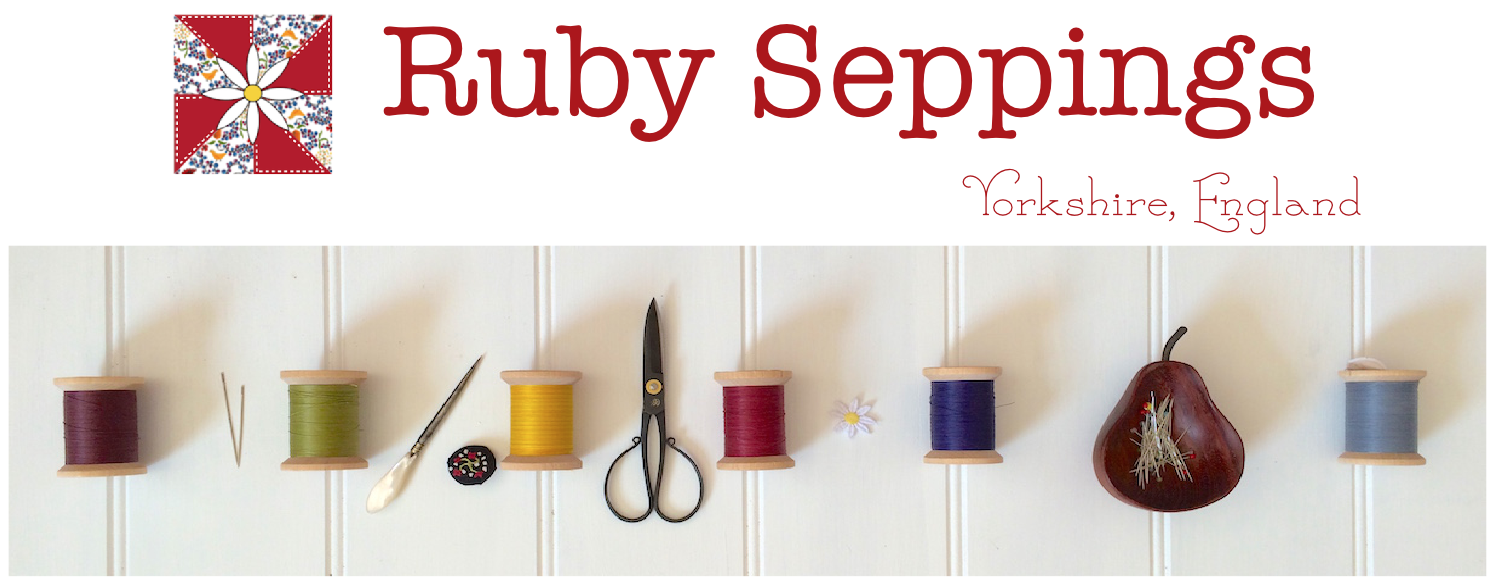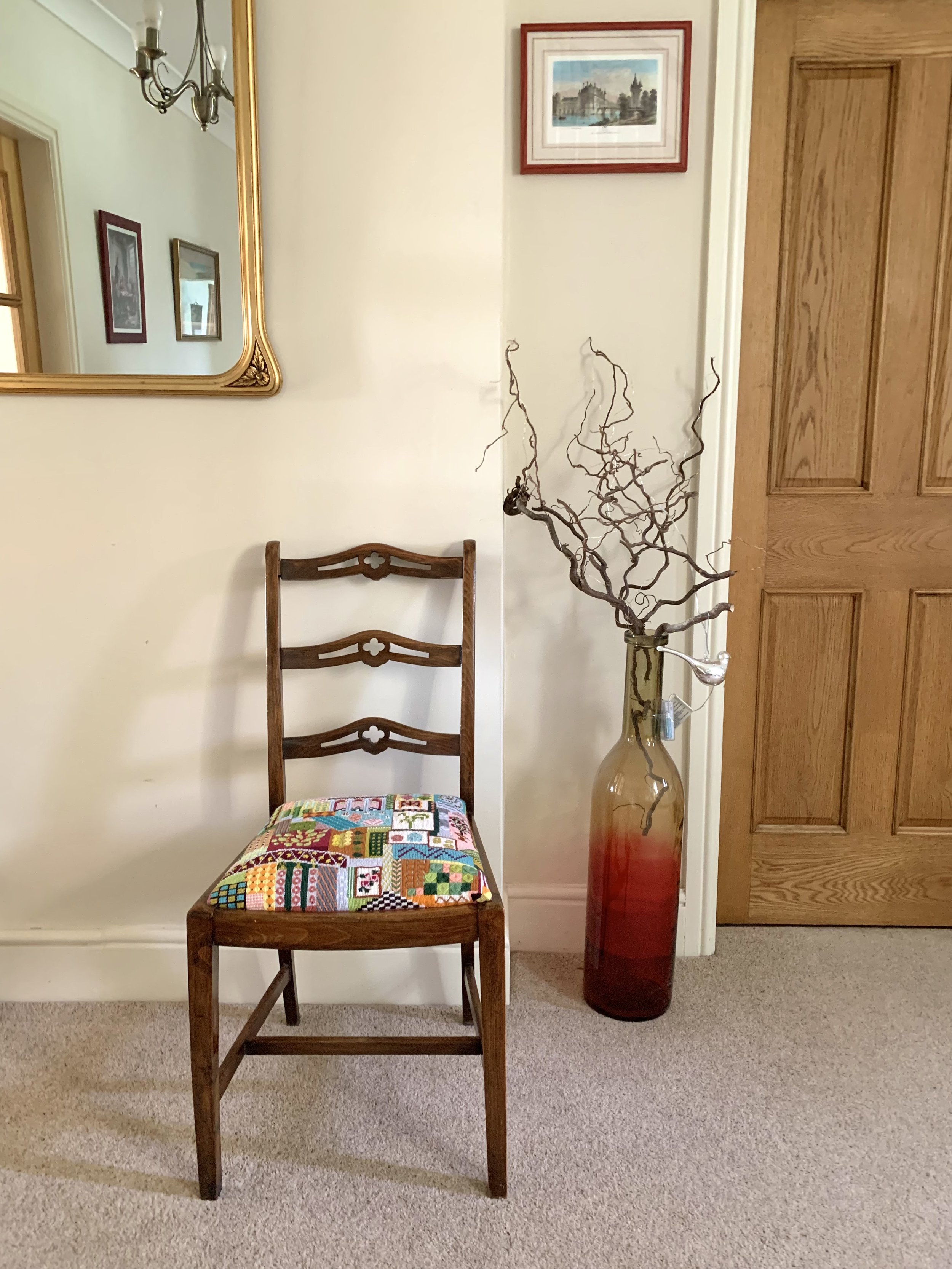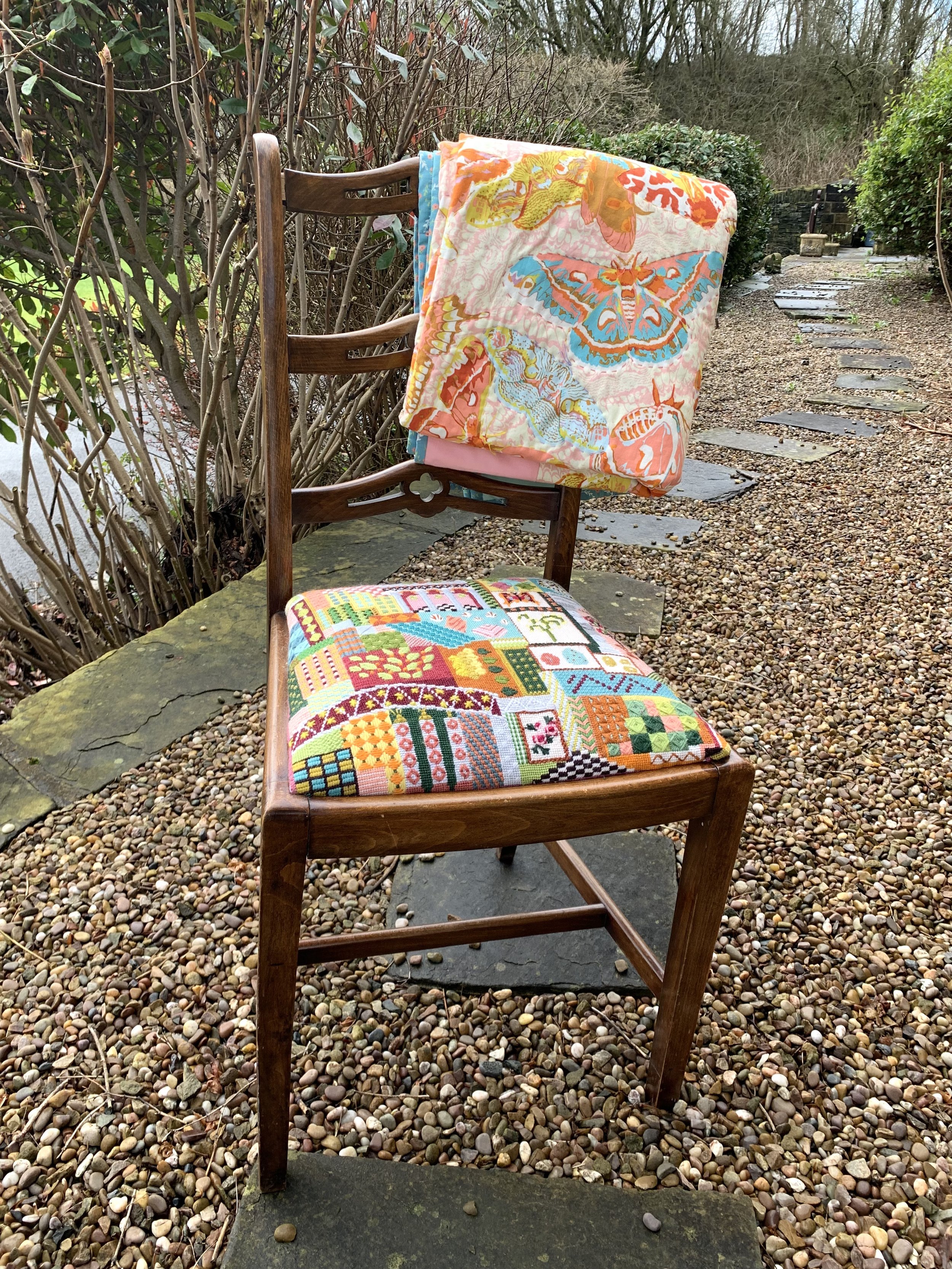Making a freestyle needlepoint seat cover inspired by the Natural History Museum
/Hello there…. it’s been a few weeks since I have had a chance to post but this one is a bit special. What an epic project!
I have posted about a return to needlepoint before….it began with making a pincushion inspired by Anna Maria Horner’s book Needleworks Notebook and from seeing images of one on her sewing table. Many years ago, I did do some tapestry but nothing of note and it seemed a really sort of old fashioned thing that had got lost in the sands of time. Anna Maria Horner is a bit of champion of it’s revival and what working the pincushion showed me is that you don’t have to just to tent stitch - you can add texture and pattern too. You can read more about this here
I took this idea and decided to make a tapestry cover for a wooden box and it turned out to be just one of the best things I had ever made. It was completely freestyle and you can see more about that project here.
Well, I was so enamoured with the whole freestyle design aesthetic that I decided that next I would make a seat cover for an old chair that has been languishing in the obscurity in our garage for several years. It is such a pretty chair too, I don’t know why I left it so long because the feeling of giving a piece of furniture a whole new life and a story of it’s own is incredibly appealing to me. Perhaps it was just one of those things that needed a thunderbolt of inspiration. This came after I visited the Natural history museum in London in the autumn of 2022. It really is decades since I last went there and I was completely overwhelmed by the magnificence of the building from the moment I stepped inside. It is a completely magical place and I had no idea of this at all.
Designed by Alfred Waterhouse, the Natural History Museum opened in London on 18 April 1881. The whole museum quarter in South Kensington is a testament to the Victorian mastery of building and design and all of those museums feel as if they are built to last forever. No expense was spared in making this monument to collections from all over the world and a space of learning and scientific research. It simply fills you with wonder from the moment you step inside and the magic of the natural kingdom comes alive in this safe and majestic home.
I wondered if all these years of embroidery and working with fabric have heightened my awareness of design and texture because this building is such a feast for the eyes and so inspirational you almost do not know where to look first. It feels as if there is barely a surface untouched. The carving on every pillar, every cornice, every step is just incredible and all this before you have even looked at the exhibits.
I was so enraptured with it all that I wanted to know more and in the shop, I purchased the most gorgeous little book all about the building itself. It has become one of my most treasured books and every page is a delight. Even on the train back up to Yorkshire, I was formulating a plan - a needlepoint seat cover, based on this museum was just the flash of inspiration I needed.
After drawing the outline of the cushion pad on my canvas, I mounted the fabric on to a wooden tapestry frame. Working on a frame is important because it stops the canvas from distorting and helps keep the tension of your stitches. I would love to have a freestanding frame for this, but as it is, it is quite easy to work with keeps things taut when you are not working on it.
After my last project which is very floral, I wanted this to be more architectural and to use some of the motifs carved in the stone as a starting point. It was really the perfect way to combine experimenting with new stitches and textures with the wool and because it is just an impressionist view - nothing had to be exact as long as the theme seeped through the overall look of the piece. It was a tentative beginning…
The canvas that I am using is Zweigart cotton canvas 12 mesh. This means that there are 12 holes per inch and it does come in other sizes too, but this one seems well suited to the wool I use which is standard Anchor Tapisserie wool.
The real joy of freestyle is that you can just let the colours lead you. There are no rules and no set design, it really is just one little block at a time. As before, I used my embroidery stitch bible by Betty Barnden to set the pace. It is perhaps the most used book in my sewing room and has easy to follow diagrams of a whole plethora of stitches for each genre of embroidery. With the spiral binding, it opens out flat for reference whilst stitching and in all honesty, no self respecting sewing room should be without one of these.
The challenge of introducing some architectural motifs was just the best fun. The Museum itself is just the most incredible building and it feels like when you stand in this temple to victorian craftsmanship, not a surface is left untouched. Pattern, texture, motifs and tiles are everywhere.
What I loved about this project was the chance to experiment with bright colours. Often when people think of tapestry, it is of some fusty old seat cover in grandma’s house, but of course it doesn’t have to be like this at all. Tapestry wool is available in an enormous range of shades and you can have the best fun, mixing and combining colours and patterns.
As I got towards the finish line, I did take my canvas off the frame as I wanted to be able to balance the remaining blocks of colour and make sure that there were not glaring patches that didn’t make the piece cohesive. Sea shells, flora and fauna, fossils, butterflies, birds eggs, Victorian tiles and architectural carvings are all thrown in to the mosaic of little stitched patches. I love the vibrancy and cheerfulness of it and I can tell you that the final stitch was a heartstopping moment for me…
At the end of this mammoth stitching project, I reflected on how needlepoint has lost its place in the modern world. We are fans of the National Trust and often visit the glorious stately homes of the UK, that they maintain around the country. Nearly always, you will see tapestry in some form or other. Maybe it is a screen, a mounted picture or a covered chair or sofa. Or perhaps it is one of the enormous wall hangings that usually herald from Flanders. Last week, we were at Lyme Park in Cheshire (immortalised as Pemberly in the 1995 BBC adaptation of Pride and Prejudice). This house dated back to tudor times and had the most spectacular collection of tapestry was hangings. What is fascinating about these is that they were a form of story telling in their day. Some tell stories of great battles or religious parables and some are more decorative and tell romantic tales of the period. I thought about my little seat cover - it too tells a story. A story of a very grand victorian museum that houses thousands of tiny tales of voyages of exploration and discovery. It made me think that needlepoint can be an enduring way to tell your own story in this modern world. As my canvas has filled in, the weight and durability of the whole piece is highlighted. This seat cover will long outlive me - it has become, almost without consciousness, a heritage piece and a family heirloom and this fills my heart with joy.
It’s been a long and relaxed project and in conclusion I can say it is up cycling at the very least and it is a legacy piece of the best kind….personal, interesting and brings a smile to your face in a flash. How lovely is that….


















